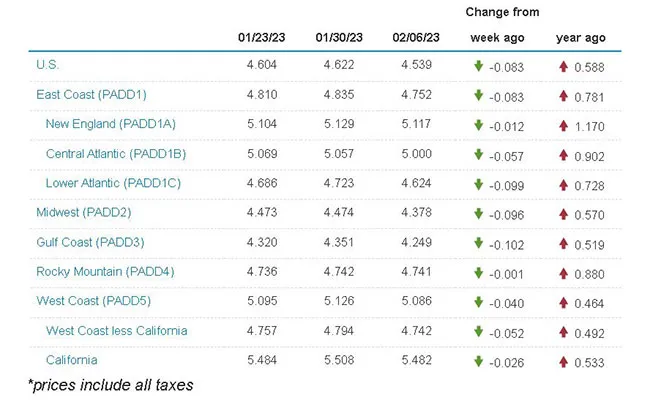Senior Reporter
Diesel Drops 8.3¢ to $4.539 a Gallon

[Stay on top of transportation news: Get TTNews in your inbox.]
The national average price of diesel slid 8.3 cents to $4.539 a gallon, according to Energy Information Administration data released Feb. 6.
Diesel’s average price declined after rising in three of the five reporting periods in January. Overall, diesel has fallen in 10 of the past 13 weeks. Trucking’s main fuel now costs 58.8 cents more than it did at this time in 2022.
The average price of diesel went down in all 10 regions in EIA’s weekly survey, from a high of 10.2 cents a gallon in the Gulf Coast to a low of just one-tenth of a cent in the Rocky Mountain area.
The national average price for a gallon of gasoline shed 4.5 cents and now sits even with where it cost at this time a year ago at $3.444 a gallon.

President Joe Biden delivers the State of the Union on Feb. 7. (Jacquelyn Martin/Bloomberg News)
In his State of the Union on Feb. 7, President Joe Biden went off of his prepared remarks when he said, even as he strongly supports climate-friendly policies and renewable energy, petroleum-based products are not going away anytime soon.
As the president was telling about a discussion he had with an oil and gas executive, Biden said the official asked him why his company should invest in fossil fuel in light of the negative business atmosphere for oil and gas projects. Biden said he responded that oil and gas would be needed for years to come.
“They said, ‘Well, we’re afraid you’re going to shut down all the oil wells and all the oil refineries. So, why should we invest in them?’ I said, ‘we’re going to need oil for at least another decade and beyond,’ ” Biden added.
The president’s remarks drew applause from Republicans and House and Senate members from oil-producing states.
U.S. On-Highway Diesel Fuel Prices

EIA.gov
On the same day, Washington, D.C.-based American Petroleum Institute wrote to House Energy and Commerce Chair Cathy McMorris Rodgers (R-Wash.) and ranking member Frank Pallone (D-N.J.) outlining what it said are several proposals to promote innovation and investment in long-term projects and cleaner energy technologies, and improved infrastructure development.

Eversole
“As Congress continues its work on these and other important energy legislation, API and our members stand ready to support policies that strengthen America’s energy security and promote economic development and environmental stewardship,” API Chief Advocacy Officer Amanda Eversole wrote. “We look forward to continuing to work with members of the committee and their colleagues in the House and Senate to support legislation that will indeed ‘pave the way to unleashing American energy sources and technologies of all kinds.’ ”
Meanwhile, according to the Baker Hughes weekly rig count, U.S. oil production slowed last week, but it is still widely ahead of 2022’s pace when production slumped.
The number of active drilling rigs in the United States fell 12 to 759 the week ending Jan. 27. That’s 146 rigs more than at this time in 2022 but 316 fewer than at the beginning of 2019, prior to the pandemic.

Host Seth Clevenger speaks with autonomous vehicle pioneer Don Burnette about the pros and cons of driverless cars and trucks. Hear the program above and at RoadSigns.TTNews.com.
Third of a three-part series on autonomous vehicles. Hear Part I here, and Part II here.
But according to EIA, crude oil production in the U.S. remained the same at 12.2 million barrels per day.
Production levels are up 700,000 barrels per day versus a year ago.
However, in its Feb. 3 oil inventory report, EIA said that crude inventories in the U.S. are up 4% above their five-year average for this time of year. The U.S. has 455.1 million barrels in inventory, and it comes after three weeks of supply stockpile buildups — two of which are considered substantial. That same week, 2.4 million barrels of oil were added to the nation’s inventory, and that followed a 2.6 million-barrel buildup the previous week.
Meanwhile, gasoline demand remains relatively weak when measured against pre-pandemic levels.
EIA reported Americans are using an estimated 8.7 million barrels of gas per day, down from a September 2019 high of 9.7 million. Gasoline production continues to outweigh demand as EIA noted refineries are producing 9.1 million barrels per day, even as output levels in the past month declined to 85.8%, down from December’s full-month average of 90.6%.
Many refineries in late winter and early spring shut down for regular maintenance, as well as to get prepared for the required change to less-polluting spring and summer blend fuels.
Want more news? Listen to today's daily briefing below or go here for more info:




